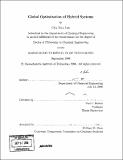Global optimization of hybrid systems
Author(s)
Lee, Cha Kun
DownloadFull printable version (35.77Mb)
Other Contributors
Massachusetts Institute of Technology. Dept. of Chemical Engineering.
Advisor
Paul I. Barton.
Terms of use
Metadata
Show full item recordAbstract
Systems that exhibit both discrete state and continuous state dynamics are called hybrid systems. In most nontrivial cases, these two aspects of system behavior interact to such a significant extent that they cannot be decoupled effectively by any kind of abstraction and must be analyzed simultaneously. Hybrid system models are important in many areas of science and engineering, including flip-flops and latching relays, manufacturing systems, air-traffic management systems, controller synthesis, switched systems, chemical process systems, signaling and decision making mechanisms in (biological) cells, robotic systems, safety interlock systems, and embedded systems. The primary focus of this thesis is to explore deterministic methods for the global optimization of hybrid systems. While the areas of modeling, simulation and sensitivity analysis of hybrid systems have received much attention, there are many challenging difficulties associated with the optimization of such systems. The contents of this thesis represent the first steps toward deterministic global optimization of hybrid systems in the continuous time domain. There are various reasons for wanting to solve optimization problems globally. (cont.) In particular, there are many applications which demand that the global solution be found, for example, formal safety verification problems and parameter estimation problems. In the former case, a suboptimal local solution could falsely indicate that all safety specifications are met, leading to disastrous consequences if, in actuality, a global solution exists which provides a counter example that violates some safety specification. In the latter case, a suboptimal local solution could falsely indicate that a proposed model structure did not match experimental data in a statistically significant manner, leading to the false rejection of a valid model structure. In addition, for many optimization problems in engineering, the presence of nonlinear equality constraints makes the optimization problem nonconvex such that local optimization methods can often fail to produce a single feasible point, even though the problem is indeed feasible. The control parameterization framework is employed for the solution of the optimization problem with continuous time hybrid systems embedded. A major difficulty of such a framework lies in the fact that the mode sequence of the embedded hybrid system changes in the space of the optimization decision variables for most nontrivial problems. (cont.) This makes the resulting optimization problem nonsmooth because the parametric sensitivities of the hybrid system do not exist everywhere, thus invalidating efficient gradient based optimization solvers. In this thesis, the general optimization problem is decomposed into three subproblems, and tackled individually: (a) when the mode sequence is fixed, and the transition times are fixed; (b) when the mode sequence is allowed to vary, and the transition times are fixed; and (c) when the mode sequence is fixed, and the transition times are allowed to vary. Because even these subproblems are nontrivial to solve, this thesis focuses on hybrid systems with linear time varying ordinary differential equations describing the continuous dynamics, and proposes various methods to exploit the linear structure. However, in the course of solving the last subproblem, a convexity theory for general, nonlinear hybrid systems is developed, which can be easily extended for general, nonlinear hybrid systems. Subproblem (a) is the easiest to solve. A convexity theory is presented that allows convex relaxations of general, nonconvex Bolza type functions to be constructed for the optimization problem. This allows a deterministic branch-and-bound framework to be employed for the global optimization of the subproblem. (cont.) Subproblems (b) and (c) are much more difficult to solve, and require the exploitation of structure. For subproblem (b), a hybrid superstructure is proposed that enables the linear structure to be retained. A branch-and-cut framework with a novel dynamic bounds tightening heuristic is proposed, and it is shown that the generation of cuts from dynamic bounds tightening can have a dramatic impact on the solution of the problem. For subproblem (c), a time transformation is employed to transform the problem into one with fixed transition times, but nonlinear dynamics. A convexity theory is developed for constructing convex relaxations of general, nonconvex Bolza type functions with the nonlinear hybrid system embedded, along with the development of bounding methods, based on the theory of differential inequalities. A novel bounding technique that exploits the time transformation is also introduced, which can provide much tighter bounds than that furnished utilizing differential inequalities.
Description
Thesis (Ph. D.)--Massachusetts Institute of Technology, Dept. of Chemical Engineering, 2006. Includes bibliographical references (p. 339-353).
Date issued
2006Department
Massachusetts Institute of Technology. Department of Chemical EngineeringPublisher
Massachusetts Institute of Technology
Keywords
Chemical Engineering.